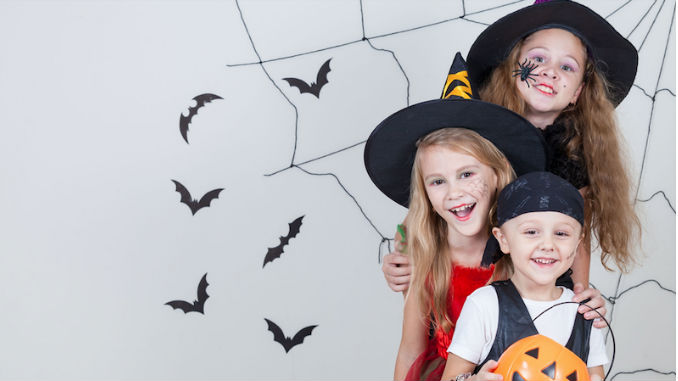
From Trick-or-Treating to Homemade Costumes, Halloween Traditions Still Make for Sweet Connections
Published: September 30, 2018
By: Shannon Dean
It’s no accident that retailers begin displaying Halloween items as early as August. Halloween generates approximately $9 billion dollars in annual revenue, making it second only to Christmas as the most profitable holiday.
However, the traditions that we associate with Halloween weren’t initially commercial in nature. They were meant to protect and connect families. And despite the current commercialization of the holiday, that spirit is still reflected in the following traditions.
TRICK-OR-TREATING: Many believe trick-or-treating originated with the ancient Gaelic festival of Samhain, which fell on Oct. 31. Villagers wore animal skins and left out food to ward off evil spirits. Later, Irish and Scottish children would perform a “trick” in exchange for treats. These traditions made their way to the United States via immigration, but the 20th century derailed trick-or-treating since during the Great Depression youths commonly vandalized property and World War II brought sugar rations.
The tradition re-emerged when suburban baby boomers began to organize neighborhood Halloween parties. Initially more of a diversion than a celebration, the gatherings would be used by adults to bribe kids who might otherwise misbehave on the holiday, says Lisa Morton, author of Trick or Treat: A History of Halloween. Today, over 70 percent of households participate in trick-or-treating, either by visiting homes in search of candy or by handing it out. The tradition is still practical since a face-to-face connection with our neighbors contributes to a sense of belonging and security.
JACK-O’-LANTERNS: Most historians believe that the carving and lighting of vegetables started in Ireland with a trickster named “Stingy Jack.” After Jack unsuccessfully attempted to deceive the devil, he was forced to walk in darkness for eternity. To light his way, Jack placed coal into the shell of a carved turnip. This story became an Irish legend called “Jack of the Lantern” or “jack- o’-lantern.” As a result, the Irish began to light and display carved potatoes and turnips to discourage spirits. Irish immigrants brought this tradition to America, which had plenty of pumpkins for carving. Almost half of current households carve about $618 million worth of jack-o’-lanterns per year, with the added value of helping children display something tangible created with their own two hands.
BOBBING FOR APPLES: Initially thought to be a Roman tradition meant to celebrate the goddess of fruit, bobbing for apples eventually morphed into a courting ritual by the 17th century. If a young girl bit into an apple on the first try, it meant that her romance would succeed. These rituals were culturally important because they offered a fun way to bring young people together at a time when marriage and large families were necessary. Fun games with friends may not always serve the same purposes today, but they can certainly guard against social isolation and encourage meaningful connections.
COSTUMES: During Samhain, people sometimes dressed in disguise while swiping food meant to discourage spirits. Welsh children often dressed as the opposite gender when they visited homes during All Saint’s Day. However, costumes didn’t become mainstream until the Industrial Revolution, when people began to crave escapism. Today’s most popular costumes are princesses, animals, and superheroes. Consumers spend around $3.4 billion dollars per year on costumes, but many families opt to make their own since this fosters creativity, allows for personalization and saves money. Though pets wear 10% of all costumes, it’s mostly humans who still enjoy pretending to be someone else, if only for a night.
HAYRIDES: This tradition began as a way for farm workers to catch a cushioned ride atop bales of hay on the way to work. By the 19th century, farm life became romanticized by urban families, so local farmers monetized this trend. In addition to hayrides, many also offered corn mazes and pumpkin patches. Haunted hayrides capitalized on the growing popularity of Halloween and are a $300 million industry today. However, there are over 2,500 hayrides worldwide, so it’s easy to find an inexpensive, family-friendly option.
HAUNTED HOUSES: Haunted houses emerged in 19th-century England when Madame Tussaud began exhibiting French monarchs with unfortunate fates. The haunted house became a cultural icon in 1969 with Disney’s Haunted Mansion. Margee Kerr, author of SCREAM: Chilling Adventures in the Science of Fear, says that because experiencing fear releases “feel good” chemicals like dopamine, scary attractions can actually encourage a sense of well-being in some. Although most experts agree that children can differentiate between fantasy and reality by age 5, most encourage parents to delay exposure to haunted houses until a child is around 7 or has expressed his own interest. When in doubt, explore the many non-scary alternatives
and re-evaluate next year.
Although Halloween has become highly commercialized, the holiday still offers inexpensive opportunities for connection. Children greatly enjoy and benefit from simple, yearly traditions. Therefore, most experts agree that it’s fine to allow kids to moderately enjoy all that Halloween has to offer. Since most kids care more about the experience than about the trappings, parents can emphasize what is truly important.
Health educator David Powell suggests that families focus not on one night of candy, but on the “social relationships and connections to others that make us human.” For many families,
Halloween allows personal interaction with our families, neighbors and communities, all things that have been important for centuries but have become increasingly difficult in our technology-centered world.
